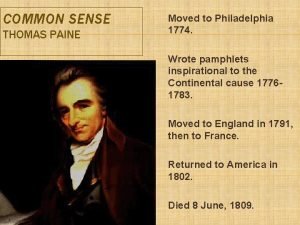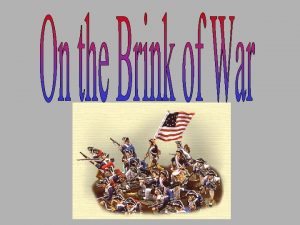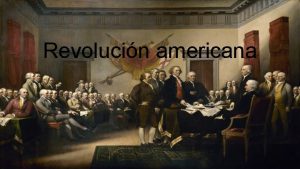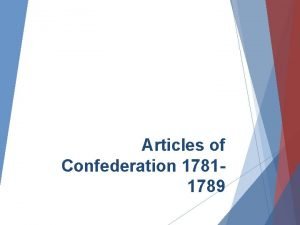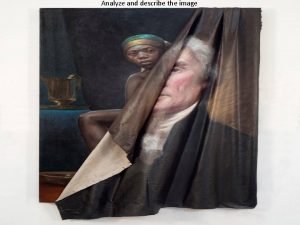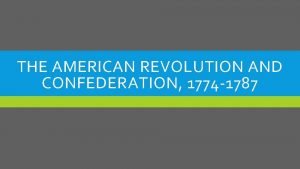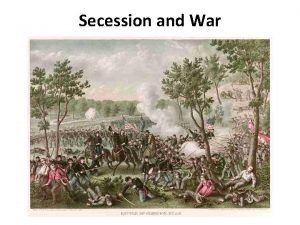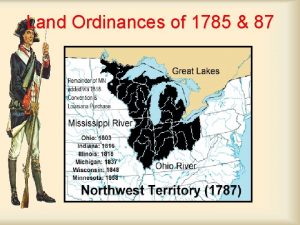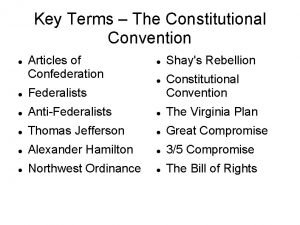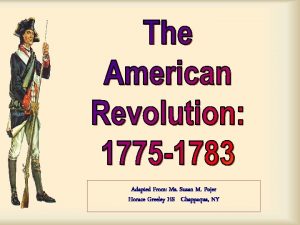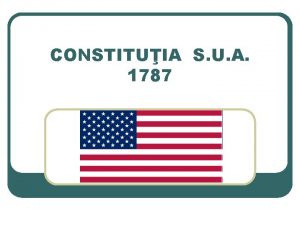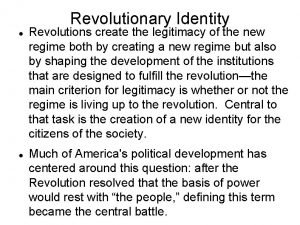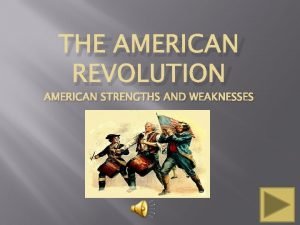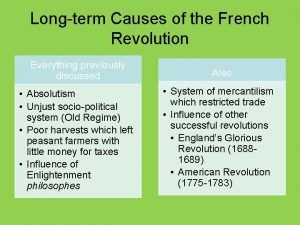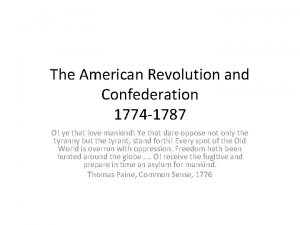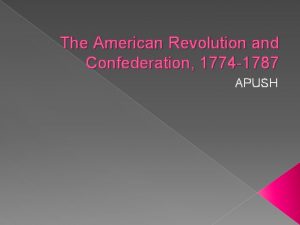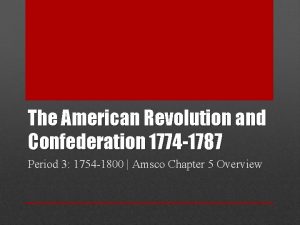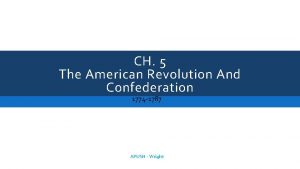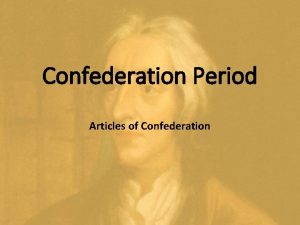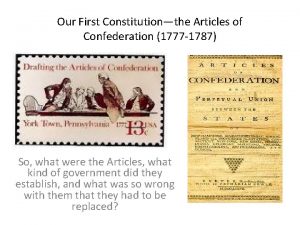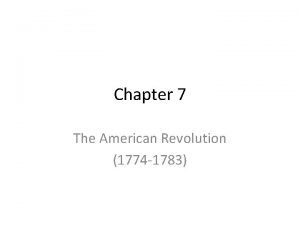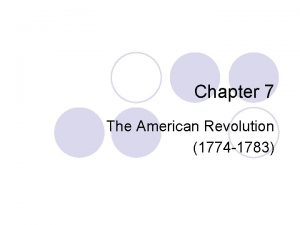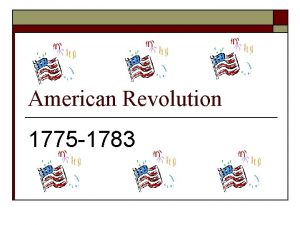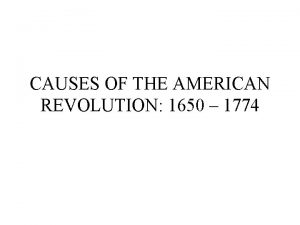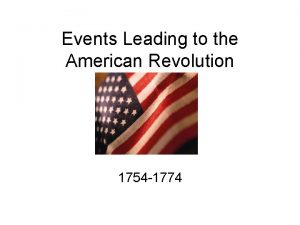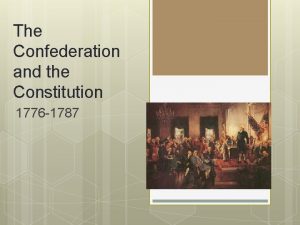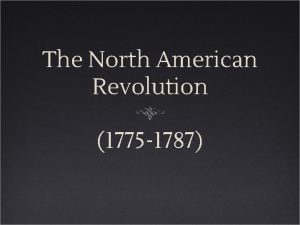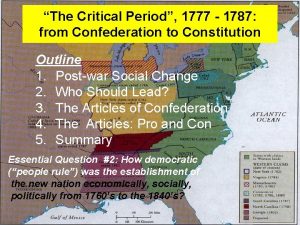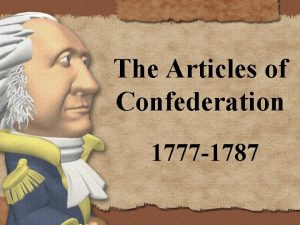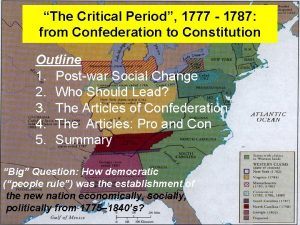THE AMERICAN REVOLUTION AND CONFEDERATION 1774 1787 FIRST

![FIRST CONTINENTAL CONGRESS September 5, 1774 Delegates from 12 colonies met [no Georgia] in FIRST CONTINENTAL CONGRESS September 5, 1774 Delegates from 12 colonies met [no Georgia] in](https://slidetodoc.com/presentation_image/768d2626507a1bef889a010e981b3de5/image-2.jpg)










![The Southern Strategy [1780 -1781] The Southern Strategy [1780 -1781]](https://slidetodoc.com/presentation_image/768d2626507a1bef889a010e981b3de5/image-13.jpg)









- Slides: 22

THE AMERICAN REVOLUTION AND CONFEDERATION, 1774 -1787
![FIRST CONTINENTAL CONGRESS September 5 1774 Delegates from 12 colonies met no Georgia in FIRST CONTINENTAL CONGRESS September 5, 1774 Delegates from 12 colonies met [no Georgia] in](https://slidetodoc.com/presentation_image/768d2626507a1bef889a010e981b3de5/image-2.jpg)
FIRST CONTINENTAL CONGRESS September 5, 1774 Delegates from 12 colonies met [no Georgia] in Philadelphia Called in response to passage of Coercive/Intolerable Acts Agreed to boycott British goods Petitioned King George III for redress of grievances Agreed to meet again if Coercive Acts were not repealed Urged colonies to set up and train militias

LEXINGTON AND CONCORD April 19, 1775 First battle of the American Revolution British were searching out rebels and weapons Colonial victory!

SECOND CONTINENTAL CONGRESS May 1775 delegates met again in Philadelphia As the Congress opened British troops attacked American fortifications on Breed’s Hill and Bunker Hill [Boston] John Adams called for the creation of a continental army in the “defense of American liberty” He also nominated George Washington to lead it

OLIVE BRANCH PETITION Colonists were divided in their support for King George III One side blamed him for supporting oppressive legislation and ordering military involvement The other side hoped that he might mediate the conflict with Parliament In July 1775, John Dickinson [who believed war with Britain would be a mistake] persuaded Congress to send the Olive Branch Petition, pleading with the king to negotiate

COMMON SENSE January 1776, Thomas Paine published Common Sense In this pamphlet he called for independence from Britain and the creation of a republican form of government “A government of our own is our natural right, ‘tis time to part. ”

DECLARATION OF INDEPENDENCE As the independence movement spread, many Loyalists and anti-independence moderates withdrew from the congress This led to the next step for Patriots: approving the Declaration of Independence [July 4, 1776] Thomas Jefferson, the main author, justified independence by vilifying George III

DECLARATION OF INDEPENDENCE Jefferson proclaimed a series of self-evident truths: All men are created equal All men possess unalienable rights [life, liberty, pursuit of happiness] The government derives its power from the people and can be rightly overthrown if it “becomes destructive of these ends” He linked individual liberty with popular sovereignty [ultimate power lands in the hands of the electorate]

Loyalist Strongholds

Washington’s Headaches Only 1/3 of the colonists were in favor of a war for independence [the other third were Loyalists, and the final third were neutral]. State/colony loyalties. Congress couldn’t tax to raise money for the Continental Army. Poor training [until the arrival of Baron von Steuben.

The Americans Military Strategies Attrition (make the British fight a long war) Guerrilla warfare tactics (you don’t have to win every battle - just wear the British down / attack and run) Make an alliance with one of Britain’s enemies. The British Break the colonies in half by getting between the No. & the So. Blockade the ports to prevent the flow of goods and supplies from an ally. “Divide and Conquer” use the Loyalists.

Saratoga: “Turning Point” of the War? A modern-day re-enactment
![The Southern Strategy 1780 1781 The Southern Strategy [1780 -1781]](https://slidetodoc.com/presentation_image/768d2626507a1bef889a010e981b3de5/image-13.jpg)
The Southern Strategy [1780 -1781]

Britain’s “Southern Strategy” Britain thought that there were more Loyalists in the Southern resources were more valuable/worth preserving. The British win a number of small victories, but cannot convert the countryside to their cause [similar to U. S. failures in Vietnam!]

The Battle of Yorktown (1781) Count de Rochambeau Admiral De Grasse

Cornwallis’ Surrender at Yorktown: Painted by John Trumbull, 1797

North America After the Treaty of Paris, 1783


Weaknesses of the Articles of Confederation A unicameral Congress [9 of 13 votes to pass a law]. 13 out of 13 to amend (change). Representatives were frequently absent. Could not tax or raise armies. No executive or judicial branches.

State Constitutions Most had strong governors with veto power. Most had bicameral legislatures. Property required for voting. Some had universal white male suffrage. Most had bills of rights. Many had a continuation of state-established religions while others disestablished religion.

Northwest Ordinance of 1787 One of the major accomplishments of the Confederation Congress! Statehood achieved in three stages: 1. Congress appointed judges & a governor to govern the territory. 2. When population reached 5, 000 adult male landowners elect territorial legislature. 3. When population reached 60, 000 elect delegates to a state constitutional convention.

Shays’s Rebellion � 1787: Massachusetts farmer Daniel Shays leads an uprising of farmers against high state taxes; finally put down by Massachusetts state militia � Importance: demonstrated that a stronger central government was needed
 8776441774
8776441774 Thomas paine 1774
Thomas paine 1774 The british coercive acts closed boston
The british coercive acts closed boston You should hope that this game will be over soon
You should hope that this game will be over soon Sophie of france (1786-1787)
Sophie of france (1786-1787) Convencion de filadelfia 1787
Convencion de filadelfia 1787 Usa 1787
Usa 1787 Northwest ordinance of 1787
Northwest ordinance of 1787 Why was the french government bankrupt in 1787
Why was the french government bankrupt in 1787 Northwest ordinance of 1787
Northwest ordinance of 1787 Northwest ordinance of 1787
Northwest ordinance of 1787 Northwest ordinance of 1787
Northwest ordinance of 1787 Northwest ordinance of 1787
Northwest ordinance of 1787 What is the northwest ordinance
What is the northwest ordinance Constitutional convention 1787
Constitutional convention 1787 Northwest ordinance of 1787
Northwest ordinance of 1787 Constitutia sua 1787
Constitutia sua 1787 Compromise
Compromise 1787-1776
1787-1776 Strengths of the continental army
Strengths of the continental army Long term causes french revolution
Long term causes french revolution American revolution strengths and weaknesses
American revolution strengths and weaknesses Russian revolution vs french revolution
Russian revolution vs french revolution

